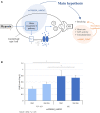The HMOX2 polymorphism contributes to the carotid body chemoreflex in European sea-level residents by regulating hypoxic ventilatory responses
- PMID: 36405624
- PMCID: PMC9669423
- DOI: 10.3389/fmed.2022.1000786
The HMOX2 polymorphism contributes to the carotid body chemoreflex in European sea-level residents by regulating hypoxic ventilatory responses
Abstract
This study investigates whether a functional single nucleotide polymorphism of HMOX2 (heme oxygenase-2) (rs4786504 T>C) is involved in individual chemosensitivity to acute hypoxia, as assessed by ventilatory responses, in European individuals. These responses were obtained at rest and during submaximal exercise, using a standardized and validated protocol for exposure to acute normobaric hypoxia. Carriers of the ancestral T allele (n = 44) have significantly lower resting and exercise hypoxic ventilatory responses than C/C homozygous carriers (n = 40). In the literature, a hypoxic ventilatory response threshold to exercise has been identified as an independent predictor of severe high altitude-illness (SHAI). Our study shows that carriers of the T allele have a higher risk of SHAI than carriers of the mutated C/C genotype. Secondarily, we were also interested in COMT (rs4680 G > A) polymorphism, which may be indirectly involved in the chemoreflex response through modulation of autonomic nervous system activity. Significant differences are present between COMT genotypes for oxygen saturation and ventilatory responses to hypoxia at rest. In conclusion, this study adds information on genetic factors involved in individual vulnerability to acute hypoxia and supports the critical role of the ≪ O2 sensor ≫ - heme oxygenase-2 - in the chemosensitivity of carotid bodies in Humans.
Keywords: Europeans; acute hypoxia; chemosensitivity; exercise; genetics; heme oxygenase-2; high altitude illness; individual vulnerability.
Copyright © 2022 Fabries, Drogou, Sauvet, Nespoulous, Erkel, Marchandot, Bouaziz, Lepetit, Hamm-Hornez, Malgoyre, Koulmann, Gomez-Merino and Chennaoui.
Conflict of interest statement
The authors declare that the research was conducted in the absence of any commercial or financial relationships that could be construed as a potential conflict of interest.
Figures

References
LinkOut - more resources
Full Text Sources
Miscellaneous

